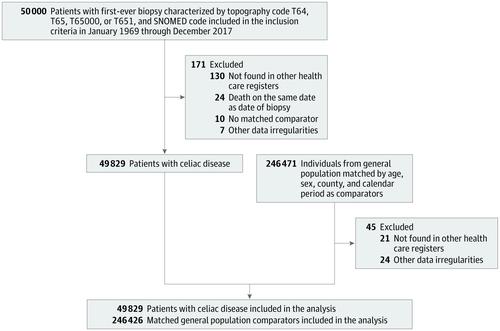Our official English website, www.x-mol.net, welcomes your feedback! (Note: you will need to create a separate account there.)
Association Between Celiac Disease and Mortality Risk in a Swedish Population
JAMA ( IF 120.7 ) Pub Date : 2020-04-07 , DOI: 10.1001/jama.2020.1943 Benjamin Lebwohl 1, 2 , Peter H. R. Green 1 , Jonas Söderling 3 , Bjorn Roelstraete 3 , Jonas F. Ludvigsson 1, 3, 4
JAMA ( IF 120.7 ) Pub Date : 2020-04-07 , DOI: 10.1001/jama.2020.1943 Benjamin Lebwohl 1, 2 , Peter H. R. Green 1 , Jonas Söderling 3 , Bjorn Roelstraete 3 , Jonas F. Ludvigsson 1, 3, 4
Affiliation

|
Importance
Celiac disease may be associated with a modest but persistent increased long-term mortality risk. It is uncertain whether this risk has changed in the era of wider diagnosis rates, less severe clinical disease, and more widespread availability of gluten-free food. Objective
To evaluate the association between celiac disease and mortality risk in a population-based cohort in Sweden. Design, Setting, and Participants
All individuals in Sweden with celiac disease diagnosed between 1969 and 2017 were identified through the Epidemiology Strengthened by histoPathology Reports in Sweden (ESPRESSO) cohort. Participants (n = 49 829) were observed starting on the day of the biopsy. The final date of follow-up was December 31, 2017. Exposures
Celiac disease was defined by the presence of small intestinal villus atrophy on histopathology specimens during the years 1969-2017 from Sweden's 28 pathology departments. Each individual was matched with as many as 5 control participants in the general population by age, sex, county, and calendar period. Main Outcomes and Measures
The primary outcome was all-cause mortality, and the secondary outcome was cause-specific mortality. Patients with celiac disease were compared with controls using stratified Cox proportional modeling, stratifying by year of diagnosis. Results
There were 49 829 patients with celiac disease, including 24% who were diagnosed between the years 2010 and 2017. The mean (SD) age at diagnosis was 32.2 (25.2) years and 62.4% were women. During a median follow-up time of 12.5 years, 13.2% (n = 6596) died. Compared with controls (n = 246 426), overall mortality was increased in those with celiac disease (9.7 vs 8.6 deaths per 1000 person-years; absolute difference, 1.2 per 1000 person-years; hazard ratio [HR], 1.21 [95% CI, 1.17-1.25]). The relative increase in mortality risk was present in all age groups and was greatest in those diagnosed in the age range of 18 to 39 years (1.9 vs 1.1 per 1000 person-years; HR, 1.69 [95% CI, 1.47-1.94]; P values for heterogeneity comparing 18-39 years with 40-59 years and with ≥60 years were both <.001). Individuals with celiac disease were at increased risk of death from cardiovascular disease (3.5 vs 3.4 per 1000 person-years; HR, 1.08 [95% CI, 1.02-1.13]), cancer (2.7 vs 2.2 per 1000 person-years; HR, 1.29 [95% CI, 1.22-1.36]), and respiratory disease (0.6 vs 0.5 per 1000 person-years; HR, 1.21 [95% CI, 1.08-1.37]). When compared with controls, the overall mortality risk was greatest in the first year after diagnosis (15.3 vs 6.5 per 1000 person-years; HR, 2.34 [95% CI, 2.14-2.55]) but persisted beyond 10 years after diagnosis (10.5 vs 10.1 per 1000 person-years; HR, 1.15 [95% CI, 1.10-1.20]). The mortality risk was likewise present for patients diagnosed during the years 2010-2017 (7.5 vs 5.5 per 1000 person-years; HR, 1.35 [95% CI, 1.21-1.51]). Conclusions and Relevance
In a Swedish population studied between 1969 and 2017, a diagnosis of celiac disease compared with the general population was associated with a small but statistically significant increased mortality risk.
中文翻译:

瑞典人群乳糜泻与死亡风险之间的关联
重要性 乳糜泻可能与适度但持续增加的长期死亡风险有关。不确定在诊断率更高、临床疾病更轻、无麸质食品更广泛供应的时代,这种风险是否发生了变化。目的 在瑞典的一个基于人群的队列中评估乳糜泻与死亡风险之间的关联。设计、设置和参与者 瑞典所有在 1969 年至 2017 年间诊断出患有乳糜泻的个体都是通过瑞典组织病理学报告强化的流行病学 (ESPRESSO) 队列确定的。从活检当天开始观察参与者(n = 49 829)。末次随访日期为2017年12月31日。暴露 乳糜泻的定义是 1969-2017 年瑞典 28 个病理科室的组织病理学标本上存在小肠绒毛萎缩。每个个体与一般人群中按年龄、性别、县和日历时间段的多达 5 名对照参与者相匹配。主要结果和措施主要结果是全因死亡率,次要结果是特定原因死亡率。使用分层 Cox 比例模型将乳糜泻患者与对照组进行比较,按诊断年份分层。结果 乳糜泻患者 49 829 例,其中 24% 的诊断时间为 2010 年至 2017 年。诊断时的平均 (SD) 年龄为 32.2 (25.2) 岁,62.4% 为女性。在中位随访 12.5 年期间,13.2% (n = 6596) 死亡。与对照组 (n = 246 426) 相比,乳糜泻患者的总死亡率增加(每 1000 人年死亡 9.7 比 8.6;绝对差异,每 1000 人年 1.2;风险比 [HR],1.21 [95%] CI,1.17-1.25])。死亡风险的相对增加存在于所有年龄组中,并且在 18 至 39 岁年龄范围内诊断出的患者中最大(每 1000 人年 1.9 对 1.1;HR,1.69 [95% CI,1.47-1.94];比较 18-39 岁、40-59 岁和≥60 岁的异质性 P 值均 <.001)。患有乳糜泻的个体死于心血管疾病的风险增加(每 1000 人年 3.5 对 3.4;HR,1.08 [95% CI,1.02-1.13])、癌症(每 1000 人年 2.7 对 2.2;HR, 1.29 [95% CI, 1.22-1.36])和呼吸系统疾病(0.6 vs 0.5 每 1000 人年;HR,1.21 [95% CI,1。08-1.37])。与对照组相比,诊断后第一年的总体死亡风险最大(每 1000 人年 15.3 vs 6.5;HR,2.34 [95% CI,2.14-2.55]),但在诊断后持续超过 10 年(10.5 vs每 1000 人年 10.1;HR,1.15 [95% CI,1.10-1.20])。2010-2017 年间诊断出的患者同样存在死亡风险(每 1000 人年 7.5 vs 5.5;HR,1.35 [95% CI,1.21-1.51])。结论和相关性 在 1969 年至 2017 年间研究的瑞典人群中,与普通人群相比,乳糜泻的诊断与死亡率风险的增加有关,但具有统计学意义。55])但在诊断后持续超过 10 年(每 1000 人年 10.5 vs 10.1;HR,1.15 [95% CI,1.10-1.20])。2010-2017 年间诊断出的患者同样存在死亡风险(每 1000 人年 7.5 vs 5.5;HR,1.35 [95% CI,1.21-1.51])。结论和相关性 在 1969 年至 2017 年间研究的瑞典人群中,与普通人群相比,乳糜泻的诊断与死亡率风险的增加有关,但具有统计学意义。55])但在诊断后持续超过 10 年(每 1000 人年 10.5 vs 10.1;HR,1.15 [95% CI,1.10-1.20])。2010-2017 年间诊断出的患者同样存在死亡风险(每 1000 人年 7.5 vs 5.5;HR,1.35 [95% CI,1.21-1.51])。结论和相关性 在 1969 年至 2017 年间研究的瑞典人群中,与普通人群相比,乳糜泻的诊断与死亡率风险的增加有关,但具有统计学意义。
更新日期:2020-04-07
中文翻译:

瑞典人群乳糜泻与死亡风险之间的关联
重要性 乳糜泻可能与适度但持续增加的长期死亡风险有关。不确定在诊断率更高、临床疾病更轻、无麸质食品更广泛供应的时代,这种风险是否发生了变化。目的 在瑞典的一个基于人群的队列中评估乳糜泻与死亡风险之间的关联。设计、设置和参与者 瑞典所有在 1969 年至 2017 年间诊断出患有乳糜泻的个体都是通过瑞典组织病理学报告强化的流行病学 (ESPRESSO) 队列确定的。从活检当天开始观察参与者(n = 49 829)。末次随访日期为2017年12月31日。暴露 乳糜泻的定义是 1969-2017 年瑞典 28 个病理科室的组织病理学标本上存在小肠绒毛萎缩。每个个体与一般人群中按年龄、性别、县和日历时间段的多达 5 名对照参与者相匹配。主要结果和措施主要结果是全因死亡率,次要结果是特定原因死亡率。使用分层 Cox 比例模型将乳糜泻患者与对照组进行比较,按诊断年份分层。结果 乳糜泻患者 49 829 例,其中 24% 的诊断时间为 2010 年至 2017 年。诊断时的平均 (SD) 年龄为 32.2 (25.2) 岁,62.4% 为女性。在中位随访 12.5 年期间,13.2% (n = 6596) 死亡。与对照组 (n = 246 426) 相比,乳糜泻患者的总死亡率增加(每 1000 人年死亡 9.7 比 8.6;绝对差异,每 1000 人年 1.2;风险比 [HR],1.21 [95%] CI,1.17-1.25])。死亡风险的相对增加存在于所有年龄组中,并且在 18 至 39 岁年龄范围内诊断出的患者中最大(每 1000 人年 1.9 对 1.1;HR,1.69 [95% CI,1.47-1.94];比较 18-39 岁、40-59 岁和≥60 岁的异质性 P 值均 <.001)。患有乳糜泻的个体死于心血管疾病的风险增加(每 1000 人年 3.5 对 3.4;HR,1.08 [95% CI,1.02-1.13])、癌症(每 1000 人年 2.7 对 2.2;HR, 1.29 [95% CI, 1.22-1.36])和呼吸系统疾病(0.6 vs 0.5 每 1000 人年;HR,1.21 [95% CI,1。08-1.37])。与对照组相比,诊断后第一年的总体死亡风险最大(每 1000 人年 15.3 vs 6.5;HR,2.34 [95% CI,2.14-2.55]),但在诊断后持续超过 10 年(10.5 vs每 1000 人年 10.1;HR,1.15 [95% CI,1.10-1.20])。2010-2017 年间诊断出的患者同样存在死亡风险(每 1000 人年 7.5 vs 5.5;HR,1.35 [95% CI,1.21-1.51])。结论和相关性 在 1969 年至 2017 年间研究的瑞典人群中,与普通人群相比,乳糜泻的诊断与死亡率风险的增加有关,但具有统计学意义。55])但在诊断后持续超过 10 年(每 1000 人年 10.5 vs 10.1;HR,1.15 [95% CI,1.10-1.20])。2010-2017 年间诊断出的患者同样存在死亡风险(每 1000 人年 7.5 vs 5.5;HR,1.35 [95% CI,1.21-1.51])。结论和相关性 在 1969 年至 2017 年间研究的瑞典人群中,与普通人群相比,乳糜泻的诊断与死亡率风险的增加有关,但具有统计学意义。55])但在诊断后持续超过 10 年(每 1000 人年 10.5 vs 10.1;HR,1.15 [95% CI,1.10-1.20])。2010-2017 年间诊断出的患者同样存在死亡风险(每 1000 人年 7.5 vs 5.5;HR,1.35 [95% CI,1.21-1.51])。结论和相关性 在 1969 年至 2017 年间研究的瑞典人群中,与普通人群相比,乳糜泻的诊断与死亡率风险的增加有关,但具有统计学意义。


























 京公网安备 11010802027423号
京公网安备 11010802027423号